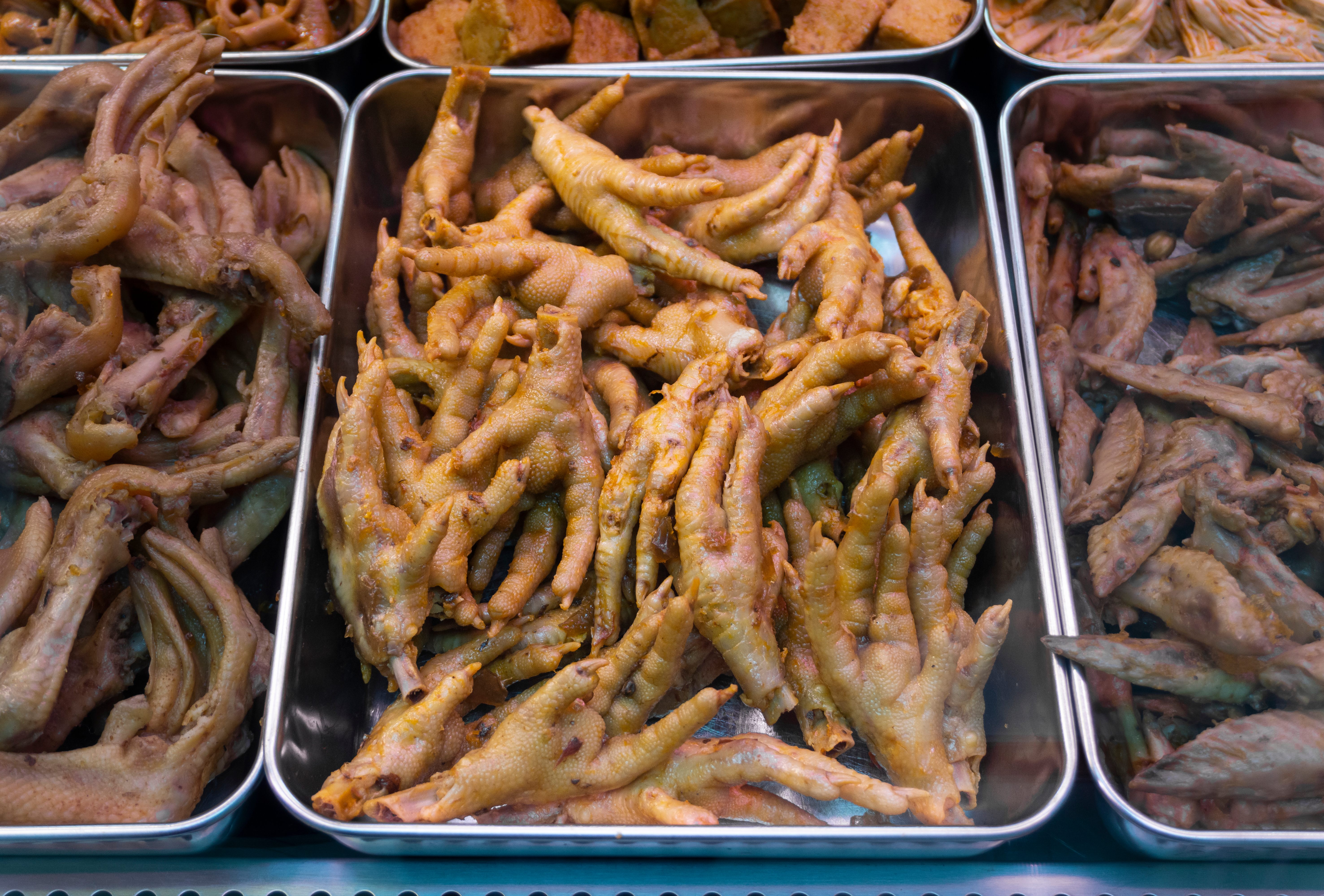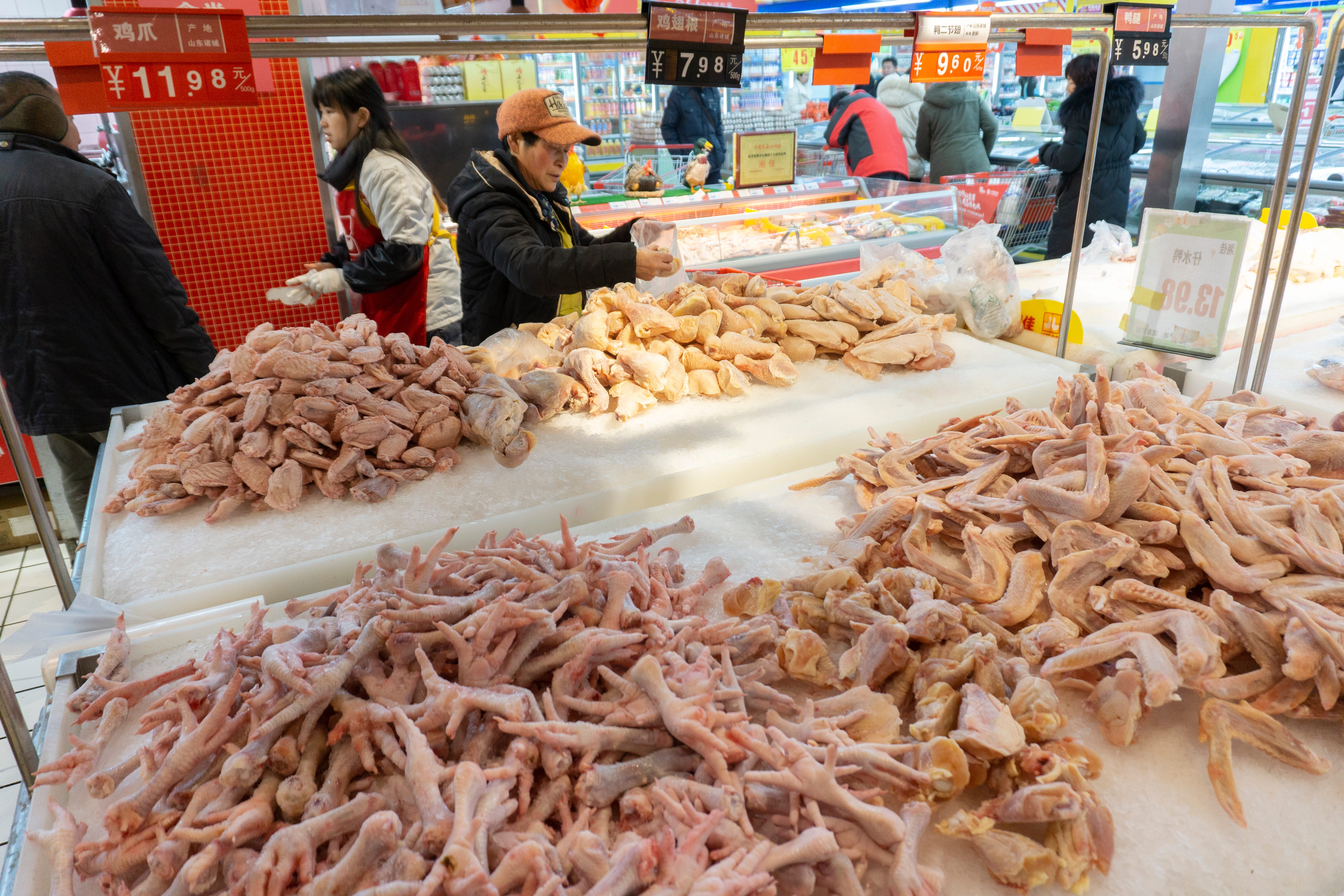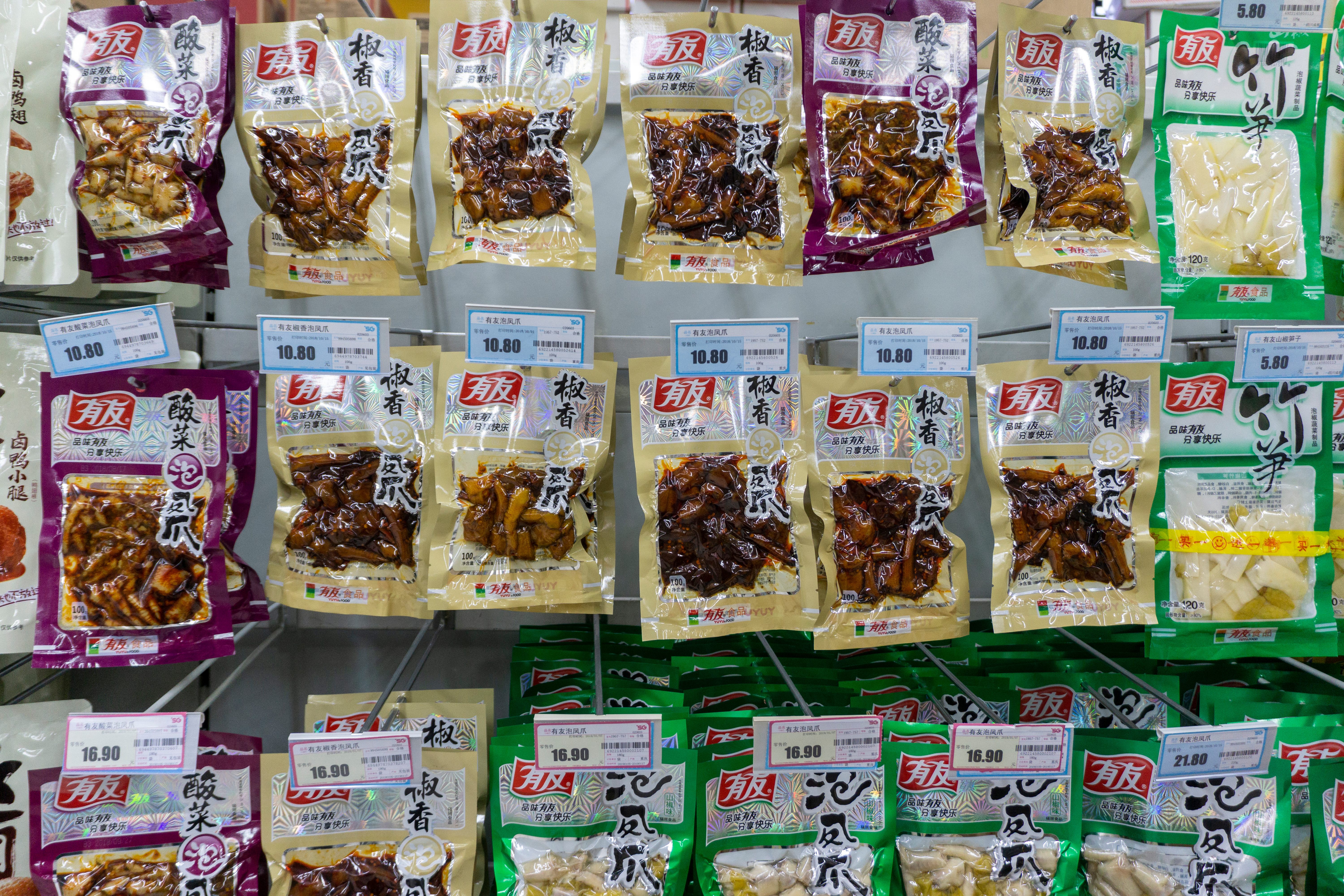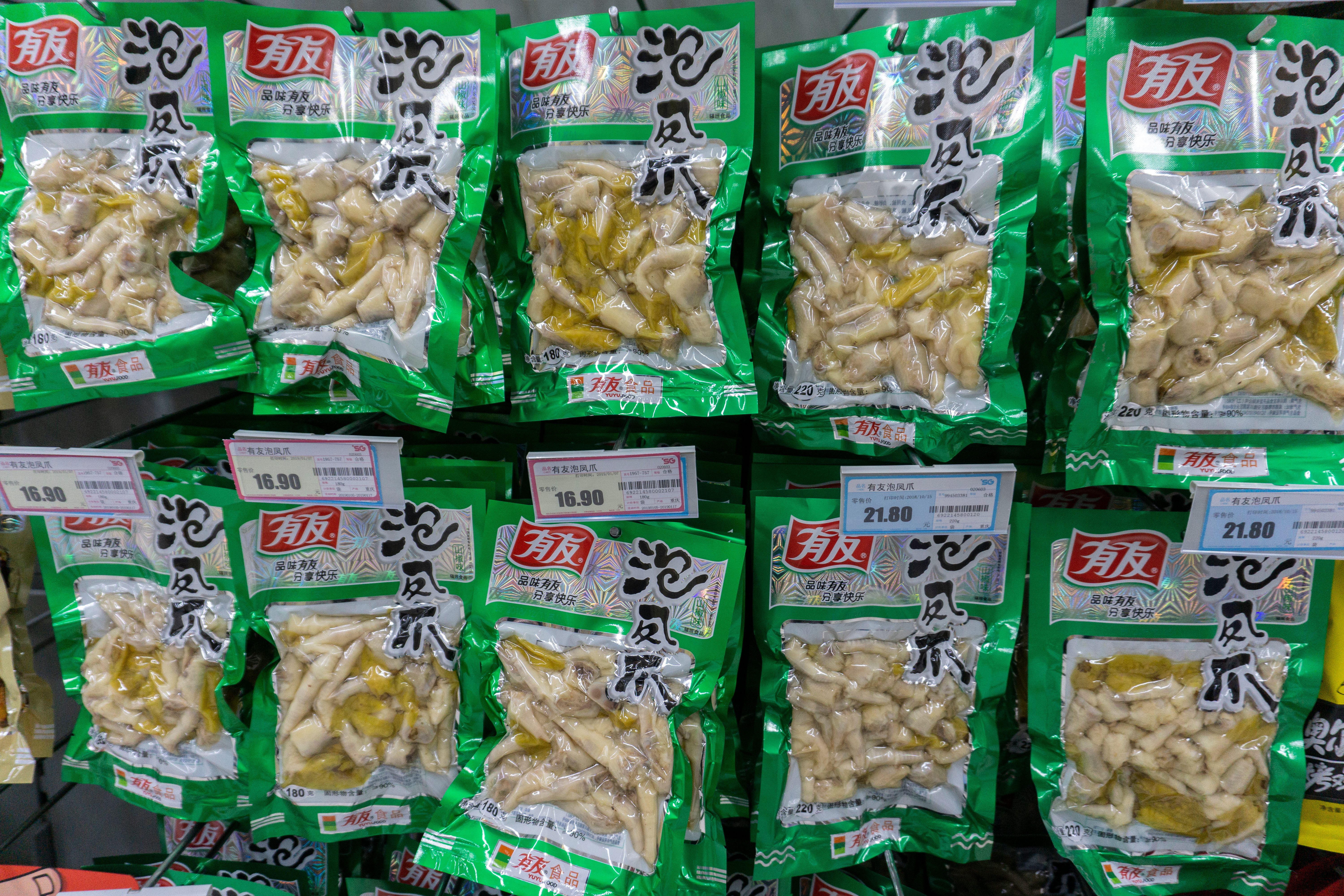Why China and America Fight Over Chicken Feet
International squabbles have stopped a once-mighty chicken foot trade.

Americans eat a lot of chicken, clocking in at almost 100 pounds per person per year. However, there’s one part of the bird many overlook: the chewy, clawed feet.
Chicken feet are a favorite treat around the world. Korea, the Philippines, Vietnam, and many other countries all have their own classic preparations of chicken feet. If there’s one place where they’re most popular, it’s China. Across the country, chicken feet are eaten everywhere from formal banquet halls to hole-in-the-wall lunch counters.
Paul Aho, a poultry economist and consultant, estimates that up to 75 percent of China’s annual chicken imports are made up solely of feet (or paws, as they’re known in the poultry industry). Most of those chicken feet once came from the world’s biggest chicken producer: the United States. But despite the massive demand, fraught international trade politics means that the epic flow of chicken feet to China has slowed to a trickle.

The sinewy, meatless appendages of skin and tendon are known by a more flattering name in Chinese: “phoenix talons,” or fèng zhǎo (凤爪). Different regions of China all have their own local spin. One popular dish is a Cantonese dim sum standard in both China and the States. The feet are fried to make the skins puffy, then simmered for several hours. Finally, they’re slathered with a sauce made from fermented red bean paste and steamed. Most recipes combine two or more cooking methods to fully tenderize the tough skin and tendons. Chicken feet can be served hot or cold, spicy or mild, in soups and stews or on their own. They’re sold as snacks in corner stores, often shrink-wrapped in plastic for convenience.
In addition to their tastiness, Chinese people are also fans of chicken feet for their health benefits. The collagen-rich snack is said to be good for the skin. Since they’re often served cold, the demand rises sharply in the warmer months of the year, between April and October. Chicken feet are eaten so frequently that they’re often more expensive than actual chicken meat. In fact, the domestic poultry industry can’t keep up with demand.

China imports nearly a billion dollars worth of poultry every year. A significant amount of that once came from the United States. “We sent a lot of paws to China, about 400,000 metric tons per year,” Aho says. American paws were particularly popular for their large size. Economists love to point to this as a classic example of gains from trade: What would otherwise be a useless leftover is a billion-dollar product in another market. American companies get extra profit from each chicken, and Chinese consumers get more of a prized delicacy.
The chicken paw case is an interesting example of how international trade affects prices. While China does produce lots of poultry, many of their chicken paws are exported to richer East Asian countries such as Korea and Japan. This lets them command higher prices, writes researcher Xiaosi Yang. Meanwhile, billions of American chicken paws are worth next to nothing in their country of origin. Yet they can be sold in China, where even a low price means the seller can extract profit from an otherwise worthless byproduct.

While it might seem like a home run for free trade, the United States and China have turned the international chicken paw trade into a subject of diplomatic wrangling, retaliatory tariffs, and even formal complaints to the World Trade Organization. Years before trade wars were the talk of Twitter, chicken feet were stirring up talk of unfair trade practices and reciprocity.
The United States and China have traditionally kept their poultry and other meat markets closed to each other. Reasons range from protectionism to food safety scares. For example, the Chinese beef market was closed to the United States after a single instance of mad cow disease was reported in Washington state in 2003. The Chinese didn’t reopen their beef market to American imports until 2017.
When China joined the World Trade Organization in 2001, however, they began importing American chicken feet rapidly. Chicken paw imports from the States grew more than 50 percent each year, even after America banned Chinese chicken in 2004 after a bird flu scare. By 2009, almost 80 percent of imported chicken feet in China came from the United States.

That year, Beijing decided enough was enough. Chinese authorities filed a complaint with the WTO, hoping to force the States to reopen their market to Chinese chicken. They also slapped chicken feet from the States with high tariffs, on the grounds that Americans were flooding the country with below-market-rate paws, and local suppliers couldn’t compete. Chicken paw imports dropped by 80 percent, and the American government in turn initiated a trade dispute at the WTO. (Chicken foot imports to Hong Kong shot up simultaneously, as smuggled goods still frequently make their way through the territory into the mainland Chinese food system.)
By 2013, the WTO had ruled in favor of the United States. But China didn’t immediately drop their tariffs, and the United States renewed their complaint in 2016. Tentatively, the two countries began working on an agreement that would allow for reciprocal market access. One potential solution was that China would drop its poultry tariffs, and the States would allow some importation of Chinese chicken products.

But in 2015, bird flu struck again. A massive outbreak in the United States led dozens of countries, including China, to close their borders to American chicken imports. While most have reopened their markets to American chicken, the Chinese have yet to do so. According to Aho, China is expected to import only 375,000 metric tons of all chicken products in 2019, a number far lower than the 400,000 tons of paws alone that they imported before the ban. As a result, America is awash with chicken feet. Most American chicken paws are now rendered for animal feed, Aho says, adding that “the value of paws for rendering is just a fraction of the value” of a paw sold in China.
Today, the Chinese market is still shut to American chicken imports. But that may change soon. In the flurry of negotiations surrounding the current trade war, the poultry industry has been pushing hard for Beijing to lift the current ban. Industry experts are confident American’s extra-large chicken feet can edge out the competitors. But for the time being, the United States has few million pounds of extra chicken feet laying around. The next time you’re ordering takeout or enjoying a dim sum brunch, consider trying some phoenix talons.
Gastro Obscura covers the world’s most wondrous food and drink.
Sign up for our regular newsletter.


























Follow us on Twitter to get the latest on the world's hidden wonders.
Like us on Facebook to get the latest on the world's hidden wonders.
Follow us on Twitter Like us on Facebook